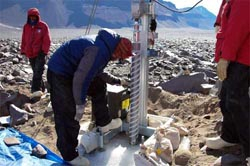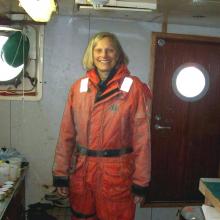Carbon Balance in Warming and Drying Tundra 2013
What Are They Doing?
 Experimental drying plots on the tundra
Experimental drying plots on the tundra
The carbon cycle is the means by which carbon is moved between the world's soils, oceans, atmosphere, and living organisms. Northern tundra ecosystems play a key role in the carbon cycle because the cold, moist, and frozen soils trap organic material and slow their decomposition. This very slowly decaying organic material has caused carbon to build up in the Arctic during the past thousands of years. Historically, the tundra has stored large amounts of carbon. Now warming in the Arctic is slowly causing the permafrost to thaw and the tundra to become warmer and dryer. As the earth warms and permafrost thaws, this previously frozen carbon is released as carbon dioxide and goes into the atmosphere, turning the tundra into a source of carbon, rather than a sink. Because carbon dioxide is a greenhouse gas, this additional carbon dioxide creates a positive feedback that leads to even further warming.
Little is known about respiration in the arctic winter. The team used five different methods in hopes of finding the best way to measure how much carbon is being released from northern ecosystems in the winter. Measuring winter respiration directly from experimentally warmed plots and understanding the drivers of wintertime tundra respiration will have the added benefit of being able to improve global arctic carbon models. More information about the project can be found here.


 The building that houses the IceCube project
The building that houses the IceCube project

 Setting up a drill site in the Dry Valleys, Antarctica
Setting up a drill site in the Dry Valleys, Antarctica

 Automatic Geophysical Observatories (AGOs)
Automatic Geophysical Observatories (AGOs)

 A hot water drill used to drill through the sea ice
A hot water drill used to drill through the sea ice

 Seismic station on the ice
Seismic station on the ice

 Scientists sampling in the Chukchi Sea
Scientists sampling in the Chukchi Sea

 Bowhead whale jawbones on the beach in Barrow, Alaska
Bowhead whale jawbones on the beach in Barrow, Alaska

 Raising a Conductivity, Temperature, and Depth (CTD) sensor
Raising a Conductivity, Temperature, and Depth (CTD) sensor

 A sample of chert unearthed at Raven Bluff, Alaska
A sample of chert unearthed at Raven Bluff, Alaska
